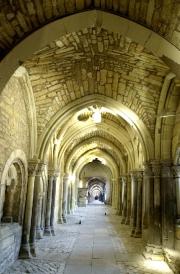For EXPO 2000 the Hornemann Institute presented an exhibition about the conservation-restoration of the cloister of St Michael's, the UNESCO-enlisted World Cultural Heritage Church.
The cloister which, in parts, dates back to the early 11th century, is today facing serious danger to its historical substance, the main reason for this being exposure to fluctuations in climate. The pre-condition for a lasting reduction of this threat is the construction of a permanent protective shelter.
Since March 1999 the cloister has been covered by a provisional protective enclosure. For this reason, there was limited access for visitors until the opening of the EXPO-exhibition. The final conservation work will be carried out now, after EXPO 2000.
The Aim
With this exhibition, the Hornemann Institute aimed at deepening the visitors' awareness of the meaning of cultural heritage, of the continuous threats to it, and of the necessity to preserve it for the coming generations.
Multi-media presentations, information tables, a documentary of the conservation-restoration work in progress as well as a collection of original sculptured stones, specially put together for this exhibition, showed the visitors a variety of ways in which modern technologies can be used for the purpose of preserving our cultural past.
A CD-ROM, an extensive, generously illustrated catalogue and a film have been issued for this exhibition.
Organizer: Hornemann Institute
Place: Church and cloister of the UNESCO World Cultural Heritage site St. Michael's Church in Hildesheim
Duration: from 1 July 2000 to 2 Oct 2000
The Deutsche Bundesstiftung Umwelt (German Federal Environment Foundation) promoted this exhibition.
The exhibition was based on the results of the work of the University of Applied Sciences Hildesheim/ Holzminden/ Göttingen, the Regional Conservation Office in Lower Saxony (Niedersächsisches Landesamt für Denkmalpflege), the Center for Science of Materials used in Cultural Properties in Northern Germany, e.V. (Norddeutsches Zentrum für Materialkunde von Kulturgut) as well as on the work of free-lance conservators-restorers. The work took place on behalf of and under the direction of the Evangelische Landeskirche.
The models were created by students of the University of Applied Sciences and Arts Hildesheim/ Holzminden/ Göttingen, Department of Architecture, under the supervision of Dr. Antje Busch-Sperveslage. The exhibition panels were designed by Markus Köhn and Andre Koller, both students of Design at the University of Applied Sciences and Arts Hildesheim/ Holzminden/ Göttingen, under the supervision of Prof. Gerd Finkel.
The cloister
Following the devastations of World War II, the western wing was the only part of the cloister of the former Benedictine monastery to remain intact. Its origins can be dated back to the early 11th c. when bishop Bernward had the monastic complex erected. The sculpturally ornamented portals of the church and of the former monastic rooms witness to the 12th c. remodelings under bishop Adelog. These phases were followed by a renovation in the second quarter of the 13th c., which characterizes the appearance of the cloister to this day. The richly decorated capitals and the famous "dragon-rib" (image) have been influenced by the "Magdeburger Bauhütte" (school of stonemasons).
During the last quarter of the 19th c., thorough conservation-restoration measures counteracted the deterioration in progress. Many components were exchanged, unsuitable materials were used in the conservation of some others.
Today the cloister again faces serious danger to its historical substance, the main reason being the fluctuations in climate, which put a strain on it. The wing of the cloister with its open arcade is considerably more exposed to weathering and to cyclic changes in temperature and relative humidity than a closed room would be. Condensation formation and an accumulation of salts on the stone surfaces result. Crystallization of these salts on the stone surfaces causes the historical building materials to flake and to sand off. Conservation-restoration surveys have shown that it will only be possible to preserve the cloister if the climatic conditions can be stabilized and measures can be taken against these harmful salts. Based on the experiences of Austrian monument-care specialists, the cloister has been covered by a provisional protective enclosure. In the framework of a pilot study for the conservation-restoration of the cloister, which could be viewed during the exhibition for EXPO 2000, a conservation/restoration concept was developed which will now be applied to the entire cloister.






